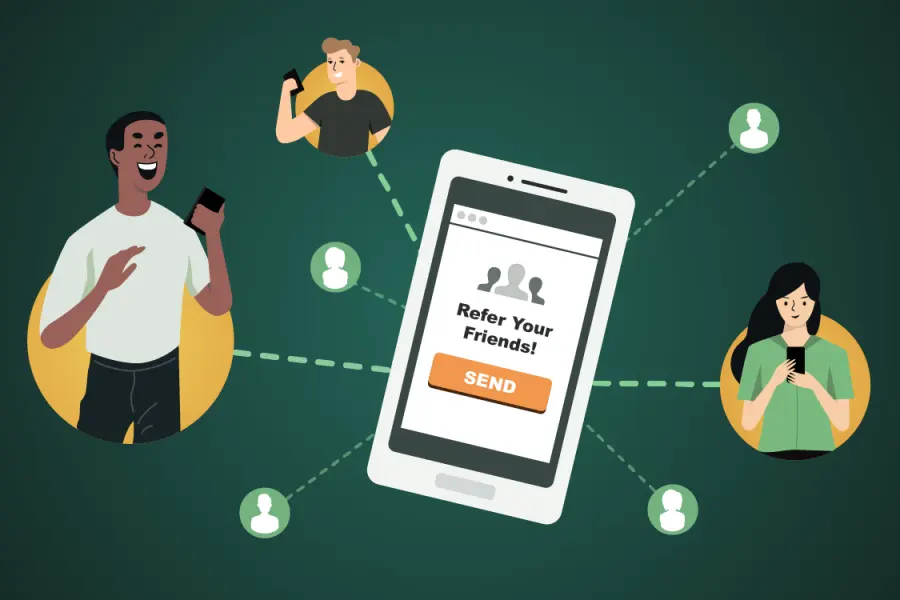For many of us, launching a local business is a dream. But you can’t just hang up an open sign and expect customers to flock to your door.
Instead, you need to get the word out through digital and traditional marketing.
So, where do you start?
This guide has you covered.
Here are 10 proven tactics you can use to get your first 100 customers and build a pipeline for more:
1. Use Local SEO To Get Found On Google
Local SEO (local search engine optimization) means making it easy for potential local customers to find your business on Google.
Specifically, optimize your website so that when people near your business-type keywords related to your products or services in Google, your site appears in their search engine results.
Here are the three basic things you need to know:
- On-Page SEO: On-Page SEO (also known as “On-Site SEO”) is what you do on your website to optimize web page content for search engines and users. This includes optimizing for keywords and creating compelling content that satisfies search intent.
- Off-Page SEO: Off-Page SEO (also known as “Off-Site SEO”) Off-page SEO is everything you do off your site to get Google and other search engines to see your website as trustworthy and authoritative. This includes building backlinks, increasing brand signals, and encouraging engagement and shares on social media.
- Technical SEO: Technical SEO ensures your website meets the technical requirements of modern search engines. This includes crawling, indexing, rendering, website architecture, and site speed.
2. Use CRO To Turn Your Website Visitors Into Customers
Competing in search engines is hard enough, but getting people to your website is only half the battle. Traffic that comes and goes with no purpose is worthless.
Whether purchasing a product, opting into email newsletters, or following you on social media, conversions justify traffic. You need traffic that converts.
And that’s where CRO comes in.
Conversion rate optimization (or CRO) improves the probability that a visitor will take the action you want on your website (i.e., make an appointment, fill out a contact form, or buy your product).
Here are the three basic steps you can take to increase conversions:
Step 1. Use A Website Builder
You need a business website that looks professional across all browsers and devices. Use a website builder if you’re not looking to spend thousands of dollars.
Website builders have everything you need, from logo creation and custom branding to building signup forms and optimizing for local searches.
They’re affordable and don’t require any special skills or experience.
Step 2. Display Social Proof
When people see others using or recommending your product, that’s social proof. It’s validation. Studies have shown that displaying social proof on your website can increase your conversion rate by more than 30%.
Testimonials, case studies, and customer reviews are great examples of trust-building social proof you could display on your website. Other examples include:
- Award Badges: If you win any industry award, place a winner’s badge on your site. And don’t be shy about showcasing any notable milestone or achievement. Your business’s website is no place to be humble.
- Membership Badges: If you belong to organizations in your industry or community, look for badges you can display on your site. It’s another excellent way of showing that authorities have vetted your business in your space.
- Certification Badges: Show off your credentials. Displaying certifications your business or employees hold relevant to your industry shows potential customers you’re up to snuff.
- Press Mentions: Like online reviews, any positive media coverage shows people your business is worthy of attention. If a popular news source mentions you, you can use their logo on your site as another trust symbol.
- Credible Research: Share credible industry research that uses expert quotes and findings that tie directly to your product’s benefits.
- Competitor Comparisons: Showcase your customer how you’re better than the competition with a side-by-side product comparison.
- Service Guarantees: Earn your customer’s confidence by offering money-back guarantees, free trials, or even free shipping.
Step 3. Apply The 7-Second Homepage Test
According to digital marketing expert Ryan Deiss, if your site can answer the following four questions in 7 seconds, your homepage is well-optimized for conversions:
- What do you do?
- What problem do you solve?
- What’s the next step (Call-To-Action)?
- Where is the Call-To-Action?
What is a Call-To-Action?
A call-to-action (CTA) is exactly what it sounds like. It’s a button or link that requests (or “calls”) for website visitors to take action (e.g., make a purchase, sign up, subscribe, download a brochure, book an appointment, etc.).
A CTA guides your website visitors through your sales process.
Website owners often make the mistake of placing their CTA at the end of their webpage or some other place where it’s not easily found.
Don’t do that.
Place your CTA above the fold to be positioned in the upper half of your website for mobile and desktop users. Visitors can easily find them without having to scroll down the page.
Here’s a great example:
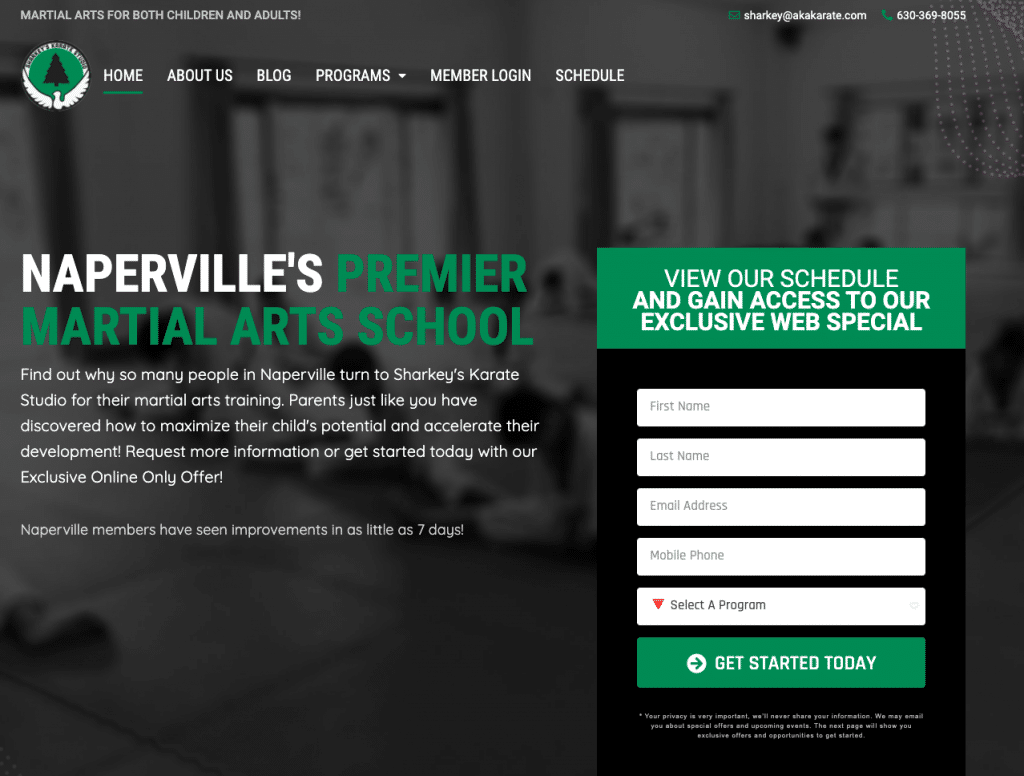
The stronger and crisper your CTA is, the more conversions you’ll make.
3. Stand Out On Google With A Free Business Profile
As of 2022, Google My Business is dead.
Google has once again revamped and renamed its local business management product. It’s now called Google Business Profile, and you must set it up for your business ASAP.
What is Google Business Profile?
Your Google Business Profile is a free tool allowing you to take charge of how your business appears on Google Search and Maps.
Your Business Profile lets you connect with customers, post updates, list your products and services, accept online orders, and more.
Here’s an example:
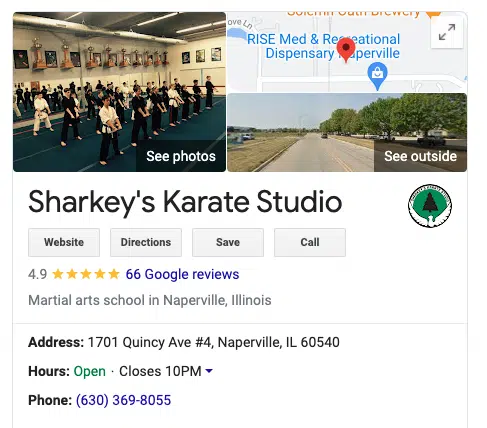
Why do you need one?
Your Google Business Profile complements your website by adding more visibility to your current business website on Google Search and Google Maps.
The big benefit: Your Google Business Profile makes it easy for customers to find your business’s location, store hours, and other info online.
How do you set it up?
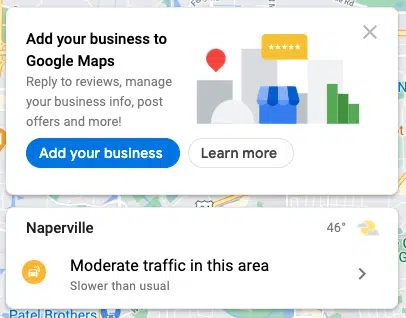
Create A New Google Business Profile Via Google Maps
Here’s how:
Step 1. On your computer, sign in to Google Maps.
Step 2. You can add your business in 3 ways:
- Enter your address in the search bar. On the left, in the Business Profile, click Add your business.
- Right-click anywhere on the map. Then, click Add your business.
- In the top left, click Menu Menu and then Add your business.
Step 3. Follow the on-screen instructions to finish signing up for your Business Profile.
Claim An Existing Business Via Google Maps
Here’s how:
Step 1. On your computer, open Google Maps.
Step 2. In the search bar, enter the business name.
Step 3. Click the business name and choose the correct one.
Step 4. Click Claim this business and then Manage now.
- To choose a different business, click “I own or manage another business”.
Step 5. Select a verification option and follow the on-screen steps.
4. Get More Bang For Your Advertising Buck Using Google’s Hyper-Local Pay-Per-Lead Ads
Google Local Services ads offer you another way to connect with people searching on Google for your services. But instead of pay-per-click like Google Ads, Google Local Services uses a pay-per-lead model that guarantees you more bang for your buck.
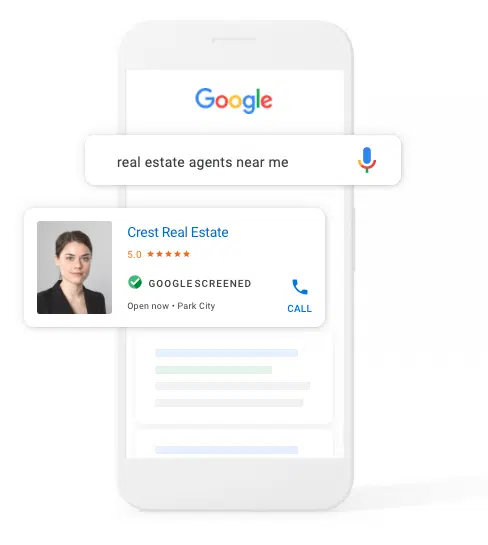
Your ads show up for customers in your service area, and you only pay if a customer calls or messages you directly through the ad.
Why do you need it?
Google Local Services Ads helps you capture leads by serving well-placed ads when potential customers search for your services. It makes it easy for customers to contact you and leave reviews.
Additionally, when you sign up for Google Local Services Ads, you get a verification badge indicating that Google has vetted your business. This builds trust with potential customers.
What does it cost?
You set your budget based on the number of leads you want. Your location and your industry determine the exact cost of your ad.
You can get an estimate using this budgeting tool.
How do you get set up?
You can sign up for Google Local Services Ads online, or if you’d like assistance, Local Services experts are available to help over the phone at no additional cost from Monday – Friday, 6am-5pm PT at 1-833-272-1444.
5. Make Friends With Other Local Business Owners & Build A Referral Network
Referral marketing is one of the best ways to grow a business. And other local businesses that offer complementary services to yours make great referral partners.
So what might this look like?
Imagine opening a bakery and wanting to enter the wedding market. Bake a batch of cupcakes to giveaway and visit event venues, photographers, and florists.
After introducing yourself and giving away your cupcakes, simply ask them if you could display each other’s business cards in each other’s stores.
You’ve seen these before:
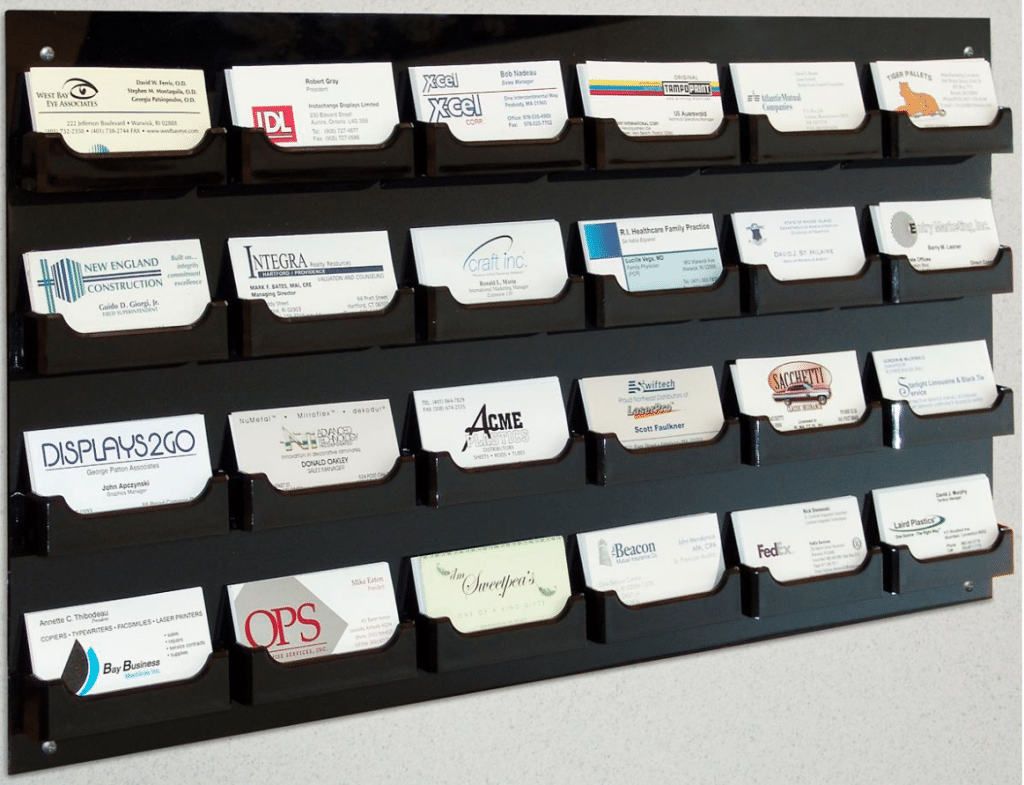
It sounds old school, but it’s a great way to help each other get more customers.
Pet stores can work with veterinarians. Plumbers can work with electricians. Hair salons with spas. Doctors with dentists, and so on.
Heck, contact your local pizza place’s owners and ask them if you could co-create a flier to be included with pizza boxes if you help pay for printing costs.
Once you’ve established a relationship, you can also team up in other ways.
Here are a few examples:
- Co-host events & fundraisers
- Run co-promotional discounts
- Link to each other’s website
- Send out a joint mailer
6. Reach Local Customers Using Traditional Offline Ads
Traditional offline marketing tactics like radio, direct mail, and billboards are great ways to reach local customers. And when you combine offline media with your online marketing efforts, you’re guaranteed to reach a larger audience.
Here are the best turnkey services for local offline advertising:
- iHeart AdBuilder: Adbuilder is a self-serve radio advertising platform that helps local businesses quickly and easily get on-air anytime from any device. It’s an affordable, targeted, and customizable service for any small business owner.
- Every Door Direct Mail: Every Door Direct Mail (EDDM) is an affordable direct mail targeting service the USPS offers to help promote small businesses to local communities. EDDM can help you send postcards, menus, and flyers to the right customers if you’re having a sale, opening a new location, or offering coupons.
- AdCritter Digital Billboards: Billboards are one of the best ways to promote your brand across a city or region. Over time, virtually everyone in town can know about your business. And now, with digital billboards, even with a modest budget, it’s never been easier to get started.
7. Use The Right Social Media Platforms To Run Ads That Reach Ready-To-Buy Customers
When done right, social media is one of the most cost-effective ways local businesses can reach customers. Why? Because you can easily target specific people in your community and track their engagement with your ads.
The real question is:
Which social media platform is right for your business?
Here are the top three social media platforms for local business advertising:
- Nextdoor: Nextdoor connects neighbors to everything nearby: local businesses, service providers, news updates, recommendations, and stuff for sale from the people down the block. This app may be the new kid on social media platforms, but it’s the most promising for local advertisers.
- Facebook Local Ads: local ads help you connect with more people in your neighborhood to increase in-store traffic and sales. You can promote your local business with Facebook by updating your accounts, advertising to the right people, and refining your campaigns.
- TikTok For Business: Don’t make ads. Make TikTok Videos geo-targeted to get in front of your local customers. TikTok is exploding right now, and its new advertising platform walks you through (step by step) how to get in on the fun. See how to use your smartphone to tap into your brand’s creative side and drive customers to your store.
8. Build A Solid Online Reputation & Get In Front Of Local Wallet-Ready Buyers
Word-of-mouth has been a marketing cornerstone for successful local businesses for over a century. And it used to be simple. You earn more business when your customers tell their friends and neighbors good things about your services.
Today, however, anyone can say anything about your business anywhere on the internet. Your online reputation reads like an amplified version of traditional word-of-mouth. And unfortunately, you may not always be in control of what’s being said.
Regardless of your industry, your customers search for your business online before they visit your store, sign up for your service, or purchase your product.
The question is: Does your online reputation attract new customers, or does it send them to your nearest competitor?
Let’s discuss how to get online reviews when you’re first starting and where it makes sense to advertise.
How do you get positive online reviews?
If you’re not nurturing your reputation and generating online reviews, new customers aren’t going to find you, or worse, you could be losing potential customers to your competitors.
Here’s how to boost your online reputation and generate more reviews:
- Under-Promise & Over-Deliver: As with collecting customer testimonials, the most important thing you can do to get great reviews is deliver a fantastic customer experience. How? The key is to under-promise (set your customer’s expectations) and then over-deliver by going above and beyond those expectations.
- Ask For Reviews: After you deliver a product or a service, it makes sense to ask your customer for a review. Don’t be pushy; never ask for a “good” review. Telling the customer what to write will kill your credibility. Just send them a friendly email request with a link to the site where you would like them to post a review.
Here’s a review request email template you can use:
Hi ____,
I noticed you recently [renewed your service/bought another product/hit a milestone]. I’m so thrilled you’re getting value from [your business]!
If it’s not too much trouble, would you mind giving us a quick review on [review site name + a hyperlink to review submission page]?
Even a sentence or two would be hugely appreciated as it will help other great customers (like you) find us online.
Thanks, and if there’s anything I can do to help you, don’t hesitate to let me know.
Sincerely,
[Your Name]
Here are the best review management tools for local businesses:
- GatherUp: Gather customer feedback and reviews into one place to drive sales up for your business.
- AskNicely: The platform for service businesses to empower their frontline teams, make every customer experience awesome, and accelerate growth.
- Demandforce: Seamlessly capture and publish reviews to the sites that matter most to your business.
- GradeUs: A simple and effective way to get client reviews and grow your agency.
- Podium: Get more reviews, collect payments, send text marketing campaigns, and centralize your communications — all from one easy-to-use platform.
Here are the best review sites for local businesses:
- Angi (formerly Angie’s List)
- Apartments.com
- ApartmentRatings
- Avvo
- BBB (Better Business Bureau)
- Caring.com
- Checkatrade
- Citysearch
- Clutch
- DealerRater
- Edmunds.com
- Foursquare
- Healthgrades
- HomeAdvisor
- HomeStars
- Houzz
- Lawyers.com
- NursingHomes.com
- OpenTable
- RateABiz
- RateMDs
- Rehab.com
- Rent.com
- SeniorAdvisor.com
- Shopper Approved
- SiteJabber
- SolarReviews
- Thumbtack
- TripAdvisor
- Untappd
- Vitals
- Vrbo
- WeddingWire
- Weedmaps
- WhatClinic.com
- YP.com
- Yell.com
- Yelp
- Zillow
- ZocDoc
9. Use Coupon Advertising To Increase Interest And Get First-Time Buyers In The Door
As old-school as coupon advertising may sound, coupons are still highly effective. About 50% of all businesses use coupon advertising.
So, if you’re not using this (surprisingly modern) marketing method, you might be missing out.
Here are the top three coupon advertising platforms for local businesses:
- Valpak: Valpak’s “Blue Envelope” coupon book is the most recognized direct mail service, driving response and awareness through advanced targeting for over 50 years. Just choose your ideal neighborhoods (target market), and they will do the rest.
- LocalFlavor.com: LocalFlavor.com combines direct mail with e-commerce to drive traffic to your business and deliver coupons and deals to customers who want them and are actively seeking them out.
- Groupon: Groupon isn’t just a deals platform — it’s an experience marketplace. It’s where people go when they want to explore while on vacation or see a new part of their town. Your business has something to offer. Groupon’s platform can bring you visitors.
10. Host A Fundraiser To Connect With Your Community And Earn New Customers
Engaging in your community is a great way to promote your local business and earn new customers.
It could be as simple as sponsoring a local sports team, holding a fundraiser for a local youth club, or supporting some other community project or organization like a school and church.
Here’s a great example:
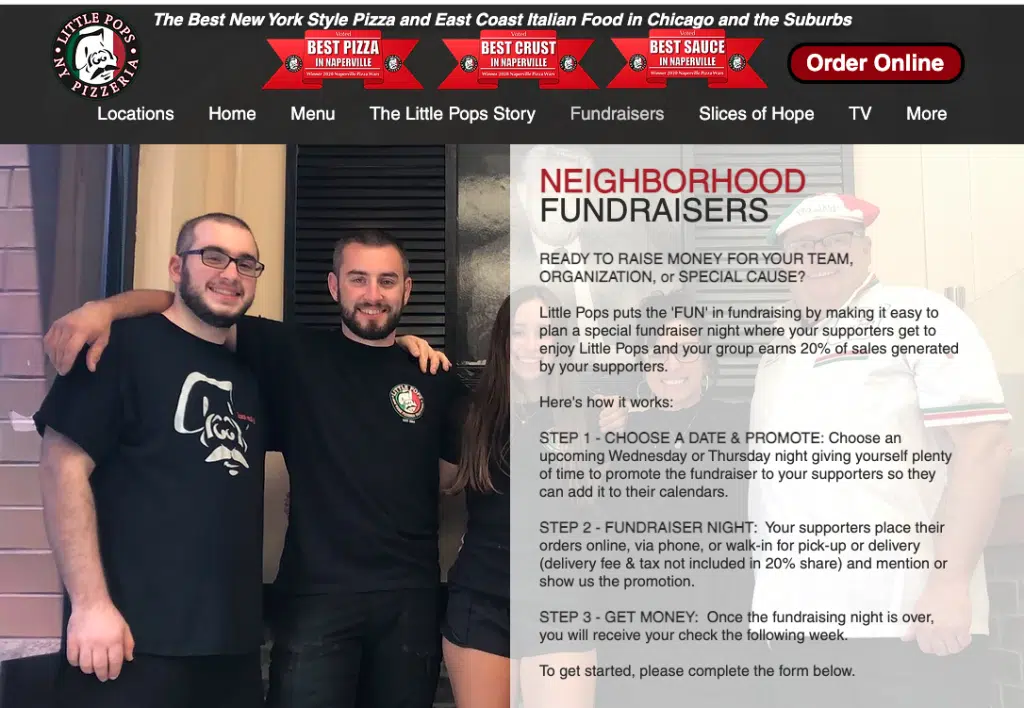
These fundraisers put your business on people’s radar, helping your local community and giving you good press.
As you can see here:

All of which will lead to more customers for your local business.
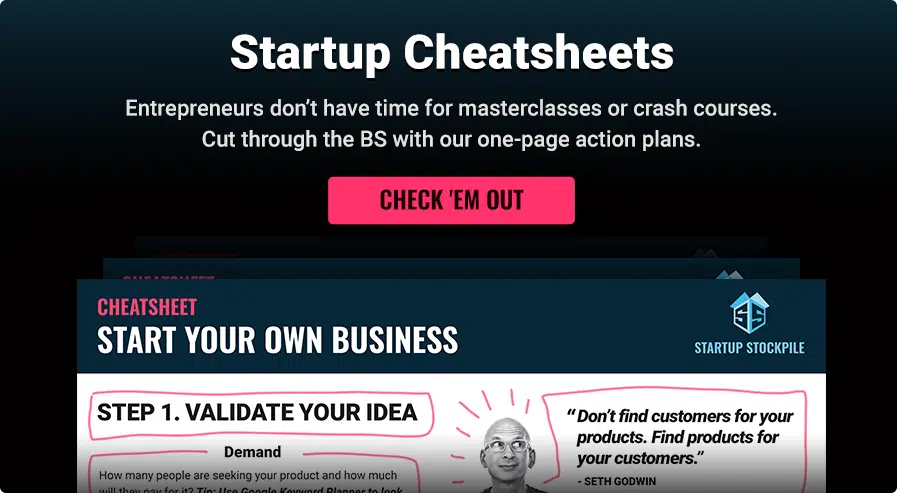
Editor’s Note: The article is part of the blog series Grow Your Business, brought to you by the marketing team at Unitel, the virtual phone system priced and designed for startups and small business owners.



